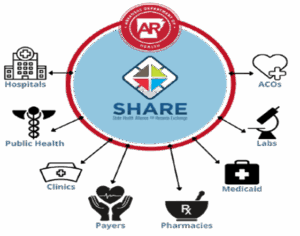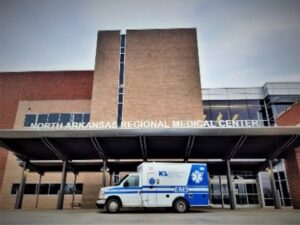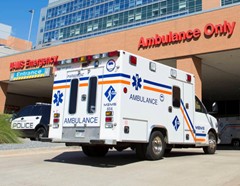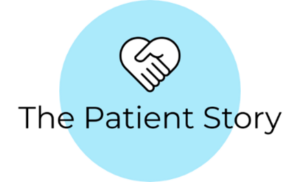
Dear SHARE HIE Participants,
As we reflect on this season of gratitude, we want to take a moment to sincerely thank each of you for your continued collaboration, partnership, and commitment to health information exchange across Arkansas. Your participation in SHARE HIE is not simply a technical connection, it is a lifeline that strengthens care delivery, supports providers, and improves the health outcomes of the patients we all serve.
 Because of your dedication to connecting, sharing, and using data, Arkansas patients are benefiting in meaningful and measurable ways every single day. Together, we are building a more connected healthcare ecosystem that places patients at the center of care and empowers providers with timely, actionable information.
Because of your dedication to connecting, sharing, and using data, Arkansas patients are benefiting in meaningful and measurable ways every single day. Together, we are building a more connected healthcare ecosystem that places patients at the center of care and empowers providers with timely, actionable information.
Your Collaboration is Making a Real Impact by:
- Improving care coordination by ensuring providers have access to complete patient histories across care settings.
- Reducing duplicate tests and procedures, saving patients time and lowering healthcare costs.
- Enhancing patient safety through real-time access to allergies, medications, diagnoses, and prior encounters.
- Strengthening transitions of care, especially during hospital admissions, discharges, and emergency department visits.
- Enabling proactive follow-up through ED and inpatient discharge notifications to primary care providers, behavioral health providers, and care managers.
- Supporting population health and risk stratification across ACOs, CINs, and payer networks.
- Enhancing behavioral health integration, ensuring holistic care for the whole patient.
Your participation in SHARE HIE demonstrates a shared commitment to improving healthcare access, quality, and efficiency for every Arkansan. This unified approach allows us to move from fragmented care toward a truly connected system that prioritizes outcomes, access, and patient-centered care.
We are incredibly thankful for your trust, your innovation, and your ongoing partnership. Together, we are not just connecting data, we are connecting lives, improving outcomes, and shaping the future of healthcare in Arkansas.
With sincere appreciation,
SHARE HIE Team
Office of Health Information Technology, Arkansas Department of Health
State Health Alliance for Records Exchange (SHARE)

 A Unified Network of Women’s Health Providers
A Unified Network of Women’s Health Providers Improving Maternal Health Through Better Information
Improving Maternal Health Through Better Information A Shared Vision for Healthier Communities
A Shared Vision for Healthier Communities About Unified Women’s Healthcare:
About Unified Women’s Healthcare: About Women’s Health Associates of NWA:
About Women’s Health Associates of NWA:  About Conway Women’s Health Center:
About Conway Women’s Health Center:  This recognition highlights SHARE HIE’s leadership in advancing interoperability and data exchange across Arkansas’s healthcare ecosystem. As the state’s only statewide Health Information Exchange (HIE), SHARE connects more than 4,000 healthcare organizations and 128 hospitals, representing thousands of providers. Through real-time exchange of clinical data, including ADT (admission, discharge, transfer) notifications, laboratory results, radiology reports, progress notes, discharge summaries and continuity of care documents (CCDs), SHARE empowers providers to make informed decisions at the point of care. From hospitals and primary care clinics to behavioral health providers, EMS agencies, and payers, SHARE ensures that the right information is accessible when and where it’s needed most.
This recognition highlights SHARE HIE’s leadership in advancing interoperability and data exchange across Arkansas’s healthcare ecosystem. As the state’s only statewide Health Information Exchange (HIE), SHARE connects more than 4,000 healthcare organizations and 128 hospitals, representing thousands of providers. Through real-time exchange of clinical data, including ADT (admission, discharge, transfer) notifications, laboratory results, radiology reports, progress notes, discharge summaries and continuity of care documents (CCDs), SHARE empowers providers to make informed decisions at the point of care. From hospitals and primary care clinics to behavioral health providers, EMS agencies, and payers, SHARE ensures that the right information is accessible when and where it’s needed most. The SHARE HIE team firmly believes that true progress in healthcare happens through collaboration, communication, and partnership. By actively engaging with hospitals, clinics, behavioral health providers, long-term care facilities, payers, and community organizations, SHARE fosters an environment of shared learning and trust. The team prioritizes listening to partners’ needs, understanding their challenges and tailoring solutions that deliver real value. Whether it’s enhancing clinical workflows, improving data quality, or supporting interoperability goals, SHARE’s success is built on the strength of relationships and a shared commitment to improving health outcomes across Arkansas.
The SHARE HIE team firmly believes that true progress in healthcare happens through collaboration, communication, and partnership. By actively engaging with hospitals, clinics, behavioral health providers, long-term care facilities, payers, and community organizations, SHARE fosters an environment of shared learning and trust. The team prioritizes listening to partners’ needs, understanding their challenges and tailoring solutions that deliver real value. Whether it’s enhancing clinical workflows, improving data quality, or supporting interoperability goals, SHARE’s success is built on the strength of relationships and a shared commitment to improving health outcomes across Arkansas.




 Looking Ahead
Looking Ahead Through the integration, ADT (Admission, Discharge, Transfer) notifications, laboratory results, radiology reports, progress notes, and CCD (Continuity of Care Documents) flow directly from the nursing homes into SHARE. Access Medical Clinic Arkansas LTC providers are documenting when they see a patient in their Athena One EMR, which is fully integrated with SHARE at their respective facilities they serve. This ensures that providers have a complete, up-to-date view of each resident’s health status without the delays and information gaps that often come with transitions of care.
Through the integration, ADT (Admission, Discharge, Transfer) notifications, laboratory results, radiology reports, progress notes, and CCD (Continuity of Care Documents) flow directly from the nursing homes into SHARE. Access Medical Clinic Arkansas LTC providers are documenting when they see a patient in their Athena One EMR, which is fully integrated with SHARE at their respective facilities they serve. This ensures that providers have a complete, up-to-date view of each resident’s health status without the delays and information gaps that often come with transitions of care. One of the most powerful features of this partnership is real-time event notifications. When a nursing home or rehab patient visits the emergency department (ED), is admitted to the hospital (IP), or returns to the facility, SHARE alerts the provider. This immediate visibility allows the provider to schedule timely follow-ups, often the next day, ensuring continuity of care and reducing the risk of complications.
One of the most powerful features of this partnership is real-time event notifications. When a nursing home or rehab patient visits the emergency department (ED), is admitted to the hospital (IP), or returns to the facility, SHARE alerts the provider. This immediate visibility allows the provider to schedule timely follow-ups, often the next day, ensuring continuity of care and reducing the risk of complications. About Access Medical Clinic Arkansas LTC: Access Medical Clinic is a leading family practice and urgent care providing a complete complement of care and treatment options for patients throughout Arkansas, Alabama, Oklahoma, Tennessee, Texas, Georgia, North Carolina, and Indiana.
About Access Medical Clinic Arkansas LTC: Access Medical Clinic is a leading family practice and urgent care providing a complete complement of care and treatment options for patients throughout Arkansas, Alabama, Oklahoma, Tennessee, Texas, Georgia, North Carolina, and Indiana. Little Rock, Arkansas- July 2025 The State Health Alliance for Records Exchange (SHARE), Arkansas’ only statewide health information exchange housed under the Arkansas Department of Health, is proud to announce a landmark integration with the U.S. Department of Veterans Affairs (VA) via the eHealth Exchange—the nation’s largest query-based health information network, connecting federal agencies and healthcare organizations for secure, interoperable data exchange.
Little Rock, Arkansas- July 2025 The State Health Alliance for Records Exchange (SHARE), Arkansas’ only statewide health information exchange housed under the Arkansas Department of Health, is proud to announce a landmark integration with the U.S. Department of Veterans Affairs (VA) via the eHealth Exchange—the nation’s largest query-based health information network, connecting federal agencies and healthcare organizations for secure, interoperable data exchange. About the U.S. Department of Veterans Affairs – Health Care for Veterans: The Veterans Health Administration (VHA) is the nation’s largest integrated healthcare system, delivering care to over 9.1 million enrolled Veterans annually. Its network includes 1,380 healthcare facilities—comprising 170 medical centers and 1,193 outpatient clinics—dedicated to providing accessible, high-quality care to Veterans across the country.
About the U.S. Department of Veterans Affairs – Health Care for Veterans: The Veterans Health Administration (VHA) is the nation’s largest integrated healthcare system, delivering care to over 9.1 million enrolled Veterans annually. Its network includes 1,380 healthcare facilities—comprising 170 medical centers and 1,193 outpatient clinics—dedicated to providing accessible, high-quality care to Veterans across the country.
 “Connecting to SHARE has expanded our ability to care for the whole patient,” said Holly Monroe, Director of the Father Bob Allen Charitable Clinic. “We now have insights into their recent hospital visits, labs, and medications—information that helps us avoid duplication and provide more effective, continuous care, especially for those with chronic conditions.”
“Connecting to SHARE has expanded our ability to care for the whole patient,” said Holly Monroe, Director of the Father Bob Allen Charitable Clinic. “We now have insights into their recent hospital visits, labs, and medications—information that helps us avoid duplication and provide more effective, continuous care, especially for those with chronic conditions.” About Father Bob Allen Charitable Clinic: Father Bob Allen Charitable Clinic is a nonprofit medical clinic that serves uninsured low-income patients in Union County, AR. We provide primary medical care, routine lab work, medication assistance, diabetes education, weight loss programs, annual wellness visits, EKGs, and more. Our prescription assistance program is available to both clinic and non-clinic patients, therefore, we can assist qualifying adults with a prescription program no matter their provider.
About Father Bob Allen Charitable Clinic: Father Bob Allen Charitable Clinic is a nonprofit medical clinic that serves uninsured low-income patients in Union County, AR. We provide primary medical care, routine lab work, medication assistance, diabetes education, weight loss programs, annual wellness visits, EKGs, and more. Our prescription assistance program is available to both clinic and non-clinic patients, therefore, we can assist qualifying adults with a prescription program no matter their provider.
 LHC Group operates a comprehensive network of home health, hospice, and community-based service locations across Arkansas. These facilities are strategically situated to serve patients statewide, including in cities such as Little Rock, Hot Springs, Fort Smith, Jonesboro, Conway, Pine Bluff, Benton, Fayetteville, Springdale, Searcy, El Dorado, Texarkana, Harrison, Batesville, Russellville, Mountain Home, Camden, and Paragould.
LHC Group operates a comprehensive network of home health, hospice, and community-based service locations across Arkansas. These facilities are strategically situated to serve patients statewide, including in cities such as Little Rock, Hot Springs, Fort Smith, Jonesboro, Conway, Pine Bluff, Benton, Fayetteville, Springdale, Searcy, El Dorado, Texarkana, Harrison, Batesville, Russellville, Mountain Home, Camden, and Paragould. About LHC Group, Inc.- LHC Group, Inc. is a leading national provider of in-home healthcare services, offering quality, value-based care to patients primarily within the comfort and privacy of their homes. Founded in 1994 as a single home health agency in small-town America, LHC Group has grown to deliver home health, hospice, and home- and community-based services across 38 states and the District of Columbia, reaching 68 percent of the U.S. population aged 65 and older.
About LHC Group, Inc.- LHC Group, Inc. is a leading national provider of in-home healthcare services, offering quality, value-based care to patients primarily within the comfort and privacy of their homes. Founded in 1994 as a single home health agency in small-town America, LHC Group has grown to deliver home health, hospice, and home- and community-based services across 38 states and the District of Columbia, reaching 68 percent of the U.S. population aged 65 and older.
 About The Children’s Clinic
About The Children’s Clinic Tammy Barnett never imagined that a simple visit to her daughter’s church in Little Rock, Arkansas, would turn into a life-changing moment. A sudden fall left her with a broken shoulder and arm, leading to an Emergency Department (ED) visit in Little Rock. What she didn’t expect was how quickly her primary care provider (PCP) in Harrison—more than 100 miles away—would be notified and ready to support her recovery.
Tammy Barnett never imagined that a simple visit to her daughter’s church in Little Rock, Arkansas, would turn into a life-changing moment. A sudden fall left her with a broken shoulder and arm, leading to an Emergency Department (ED) visit in Little Rock. What she didn’t expect was how quickly her primary care provider (PCP) in Harrison—more than 100 miles away—would be notified and ready to support her recovery. “I was shocked to hear from my PCP so quickly,” Tammy recalled. “I had just been to the ED in Little Rock, and before I even had a chance to reach out, my doctor already knew and was checking in on me.” said Tammy Barnett*
“I was shocked to hear from my PCP so quickly,” Tammy recalled. “I had just been to the ED in Little Rock, and before I even had a chance to reach out, my doctor already knew and was checking in on me.” said Tammy Barnett*